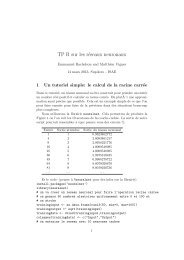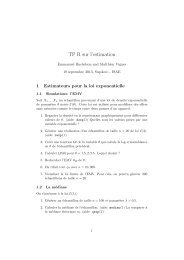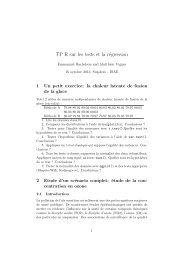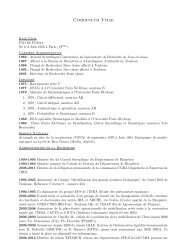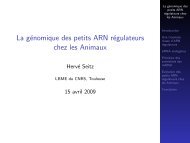Modeling the process of operational decision-making in ... - Inra
Modeling the process of operational decision-making in ... - Inra
Modeling the process of operational decision-making in ... - Inra
You also want an ePaper? Increase the reach of your titles
YUMPU automatically turns print PDFs into web optimized ePapers that Google loves.
<strong>Model<strong>in</strong>g</strong> <strong>the</strong> <strong>process</strong> <strong>of</strong> <strong>operational</strong> <strong>decision</strong>-<strong>mak<strong>in</strong>g</strong> <strong>in</strong> agriculture: a bounded rationality approach<br />
Sujet proposé par Stéphane Couture (SAE2) et Roger Mart<strong>in</strong>-Clouaire (MIA)<br />
Equipe MAD (Modélisation des Agro-écosystèmes et Décision)<br />
Unité de biométrie et Intelligence Artificielle, Toulouse-Auzeville<br />
Stephane.Couture@toulouse.<strong>in</strong>ra.fr, rmc@toulouse.<strong>in</strong>ra.fr<br />
1 Les enjeux scientifiques et socio-économiques<br />
Internationalization <strong>of</strong> markets, shifts <strong>in</strong> consumer demands and requirements, rapid evolution <strong>of</strong> technologies,<br />
and change <strong>in</strong> political context are among <strong>the</strong> recently emerg<strong>in</strong>g factors that make competitiveness much harder to<br />
achieve and ma<strong>in</strong>ta<strong>in</strong> <strong>in</strong> <strong>the</strong> agricultural production <strong>in</strong>dustry. As a production manager <strong>the</strong> farmer makes <strong>decision</strong><br />
about <strong>the</strong> tim<strong>in</strong>g, comb<strong>in</strong>ation and implementation <strong>of</strong> technical operations (till<strong>in</strong>g, plant<strong>in</strong>g, fertiliz<strong>in</strong>g, irrigat<strong>in</strong>g,<br />
spray<strong>in</strong>g, harvest<strong>in</strong>g, feed<strong>in</strong>g animals, etc.) <strong>in</strong> hope <strong>of</strong> achiev<strong>in</strong>g his objectives. The farm<strong>in</strong>g bus<strong>in</strong>ess is uncerta<strong>in</strong><br />
because <strong>the</strong> outputs <strong>of</strong> operations are subject to hardly predictable events <strong>of</strong> nature (wea<strong>the</strong>r, disease, etc.) and<br />
because it depends on chang<strong>in</strong>g and uncerta<strong>in</strong> economic factors (market demand, fluctuation <strong>of</strong> prices, <strong>in</strong>terest<br />
rate, public support etc.) for which <strong>in</strong>formation can be limited or unavailable. In such a context, <strong>the</strong> complex<br />
<strong>in</strong>teraction between natural and man-controlled <strong>process</strong>es is at <strong>the</strong> very heart <strong>of</strong> agricultural production. The<br />
amount and quality <strong>of</strong> output that result from a given bundle <strong>of</strong> <strong>in</strong>puts cannot be predicted with certa<strong>in</strong>ty, i.e., <strong>the</strong><br />
production function is stochastic because uncontrollable elements, such as wea<strong>the</strong>r, play a fundamental role <strong>in</strong><br />
agricultural production. Moreover <strong>the</strong>ir effects are heightened by <strong>the</strong> fact that time itself plays a particularly<br />
important role because long production lags are dictated by <strong>the</strong> biological <strong>process</strong>es that underlie <strong>the</strong> production<br />
<strong>of</strong> crops and <strong>the</strong> growth <strong>of</strong> animals. Price uncerta<strong>in</strong>ty is also a standard attribute <strong>of</strong> farm<strong>in</strong>g activities. Because <strong>of</strong><br />
<strong>the</strong> biological production lags, production <strong>decision</strong>s have to be made far <strong>in</strong> advance <strong>of</strong> realiz<strong>in</strong>g <strong>the</strong> f<strong>in</strong>al product,<br />
so that <strong>the</strong> market price for <strong>the</strong> output is typically not known at <strong>the</strong> time <strong>the</strong>se <strong>decision</strong>s have to be made.<br />
Although <strong>the</strong>re exists different f<strong>in</strong>ancial or <strong>in</strong>surance tools for cover<strong>in</strong>g aga<strong>in</strong>st <strong>the</strong>se multiple (correlated or not)<br />
sources <strong>of</strong> uncerta<strong>in</strong>ties, <strong>the</strong> burden <strong>of</strong> this unstable context and highly complex <strong>decision</strong> problem is still on <strong>the</strong><br />
shoulders <strong>of</strong> <strong>the</strong> farmers that will need <strong>the</strong>refore enhanced management ability.<br />
The performances <strong>of</strong> farms operat<strong>in</strong>g <strong>in</strong> similar physical and economic environments are <strong>of</strong>ten very different<br />
(Solano et al. 2006). Research shows that <strong>the</strong> difference is ma<strong>in</strong>ly due to <strong>the</strong> farm manager's <strong>decision</strong>-<strong>mak<strong>in</strong>g</strong><br />
aptitude, ability to manage uncerta<strong>in</strong>ties, and ability to properly weigh up a wide range <strong>of</strong> factors and to adapt to<br />
changes. Good management depends essentially on <strong>the</strong> manager’s technical, conceptual and diagnostic skills. The<br />
production performance is critically dependent on <strong>the</strong> ability <strong>of</strong> <strong>the</strong> farm manager to deal with <strong>the</strong> right problems<br />
and opportunities at <strong>the</strong> right moment <strong>in</strong> <strong>the</strong> right way. Farmers always had to manage uncerta<strong>in</strong>ties and adapt to<br />
changes. However, agricultural practices and knowledge were developed to deal with uncerta<strong>in</strong>ties with<strong>in</strong> <strong>the</strong><br />
limited range <strong>in</strong> which <strong>the</strong>y usually occurred. By far <strong>the</strong> majority <strong>of</strong> farm managers make <strong>decision</strong>s and<br />
implement <strong>the</strong>m on <strong>the</strong> basis <strong>of</strong> <strong>the</strong>ir <strong>in</strong>tuition or tacit knowledge, which is probably <strong>the</strong> result <strong>of</strong> years <strong>of</strong><br />
experience <strong>of</strong> outcomes <strong>of</strong> past <strong>decision</strong>s, and <strong>in</strong>teractions with colleagues and advisors. Actually <strong>the</strong>y seem to<br />
have a <strong>decision</strong>-<strong>mak<strong>in</strong>g</strong> behavior that is both plan-based and responsive to <strong>the</strong> ongo<strong>in</strong>g situation. Indeed, farmers<br />
have limited <strong>in</strong>formation about <strong>the</strong> different sources <strong>of</strong> uncerta<strong>in</strong>ties, and this aspect considerably affects how<br />
farmers make <strong>decision</strong>s. Yet, little attention has been given to <strong>the</strong> understand<strong>in</strong>g <strong>of</strong> farmers’ cognitive ability as<br />
<strong>the</strong> basic determ<strong>in</strong>ant <strong>of</strong> <strong>the</strong>ir managerial ability for strategic and day to day <strong>decision</strong>s. The <strong>in</strong>creas<strong>in</strong>g complexity<br />
<strong>of</strong> <strong>operational</strong> <strong>decision</strong>-<strong>mak<strong>in</strong>g</strong> <strong>in</strong> agriculture is a source <strong>of</strong> challeng<strong>in</strong>g questions to research <strong>in</strong> <strong>decision</strong> and<br />
management sciences. What k<strong>in</strong>ds <strong>of</strong> practical reason<strong>in</strong>g does a manager perform and what are <strong>the</strong> dist<strong>in</strong>guish<strong>in</strong>g<br />
characteristics <strong>of</strong> <strong>the</strong> pieces <strong>of</strong> <strong>in</strong>formation used <strong>in</strong> judg<strong>in</strong>g what to do? How can <strong>decision</strong> be made quickly and<br />
with almost no calculation? Enhanced analysis <strong>in</strong>struments are needed to study management behavior <strong>in</strong> different<br />
scenarios, and to identify possible flaws, vulnerability and adaptation possibilities. It is our belief that<br />
<strong>in</strong>vestigat<strong>in</strong>g <strong>the</strong>se questions may lead to descriptive approaches lead<strong>in</strong>g to improvements <strong>of</strong> farmer’s<br />
management ability.<br />
2 La (les) question(s) de recherche<br />
The sequential <strong>decision</strong> problem at <strong>the</strong> core <strong>of</strong> farm production management is primarily governed by <strong>the</strong><br />
exploitation <strong>of</strong> practical knowledge about how to handle a production <strong>process</strong> toward <strong>the</strong> achievement <strong>of</strong> some<br />
general objectives (essentially production performance target). This knowledge can be seen as a set <strong>of</strong> crisp<br />
constra<strong>in</strong>ts that restrict significantly at any time <strong>the</strong> actions that are deemed relevant to <strong>the</strong> objectives and are<br />
feasible given <strong>the</strong> actual conditions (Mart<strong>in</strong>-Clouaire & Rellier 2009, 2011). Basically <strong>the</strong>se constra<strong>in</strong>ts def<strong>in</strong>e a<br />
flexible plan that specifies temporal and procedural organization <strong>of</strong> activities, state-dependant conditions <strong>of</strong> <strong>the</strong>ir<br />
pert<strong>in</strong>ence and feasibility, and resource requirements (see for <strong>in</strong>stance Mart<strong>in</strong> et al. 2011; Rellier et al. 2011;
Ripoche et al. 2011). At any time <strong>the</strong> <strong>in</strong>terpretation <strong>of</strong> such a plan determ<strong>in</strong>es what is permitted accord<strong>in</strong>g to <strong>the</strong><br />
plan and what is possible given <strong>the</strong> limitations <strong>of</strong> resources (labor, mach<strong>in</strong>ery etc.). Given <strong>the</strong> flexibility <strong>of</strong> <strong>the</strong><br />
plan this constra<strong>in</strong>t satisfaction phase yields several sets <strong>of</strong> actions. Each set is a candidate solution. The <strong>the</strong>sis<br />
work is focused on <strong>the</strong> problem <strong>of</strong> choos<strong>in</strong>g <strong>the</strong> preferable solution to execute among <strong>the</strong> candidate ones. This<br />
k<strong>in</strong>d <strong>of</strong> choice problem has to be repeated as <strong>of</strong>ten as required by <strong>the</strong> occurrence <strong>of</strong> disruptive events that <strong>in</strong>terrupt<br />
<strong>the</strong> execution <strong>process</strong> (typically at least once a day).<br />
The central question <strong>of</strong> <strong>the</strong> <strong>the</strong>sis proposal can be stated as: how is a farm manager cognitively approach<strong>in</strong>g<br />
<strong>decision</strong>s and how is he <strong>in</strong>tegrat<strong>in</strong>g constra<strong>in</strong>ts, desires and judgment. The central question <strong>in</strong>duces two types <strong>of</strong><br />
<strong>in</strong>vestigation to:<br />
- categorize and represent <strong>the</strong> heterogeneous types <strong>of</strong> <strong>in</strong>formation taken <strong>in</strong>to account <strong>in</strong> <strong>the</strong> <strong>decision</strong>-<strong>mak<strong>in</strong>g</strong><br />
<strong>process</strong>, and determ<strong>in</strong>e how such relevant <strong>in</strong>formation can be dynamically ga<strong>the</strong>red or constructed at every<br />
<strong>decision</strong> stage;<br />
- formalize and model <strong>the</strong> <strong>decision</strong> <strong>process</strong> by which such <strong>in</strong>formation can be manipulated and comb<strong>in</strong>ed.<br />
Instantiated cases <strong>of</strong> this <strong>process</strong> should bear strong resemblance with <strong>the</strong> choice procedures observed or<br />
imag<strong>in</strong>able <strong>in</strong> real situations.<br />
In agriculture <strong>operational</strong> production management has to deal with: (1) a series <strong>of</strong> <strong>in</strong>terdependent <strong>decision</strong>s and/or<br />
actions (today’s choices have to be made <strong>in</strong> coherence with those made previously); (2) constantly chang<strong>in</strong>g<br />
situations; (3) shift<strong>in</strong>g goals and preferences. The potentially relevant pieces <strong>of</strong> <strong>in</strong>formation that drive <strong>the</strong> <strong>decision</strong><br />
<strong>process</strong> need to be extracted or even constructed for every choice task. That is, farmers need to get preferences<br />
and beliefs on <strong>the</strong> spot when needed, <strong>in</strong>stead <strong>of</strong> hav<strong>in</strong>g known, well-def<strong>in</strong>ed, and stable ones. In order to be able to<br />
understand differences between management behaviors one has first to <strong>in</strong>dentify <strong>the</strong> types <strong>of</strong> <strong>in</strong>formation <strong>in</strong>voked,<br />
<strong>the</strong>ir role <strong>in</strong> <strong>the</strong> <strong>decision</strong> <strong>process</strong> and <strong>the</strong> way <strong>the</strong>y are dynamically acquired.<br />
The choice <strong>process</strong> <strong>in</strong>volves <strong>in</strong>formation sources that <strong>in</strong>duce a restriction <strong>of</strong> <strong>the</strong> set <strong>of</strong> candidate solutions (for<br />
<strong>in</strong>stance, non urgent candidate solutions can be discarded if o<strong>the</strong>rs are urgent). Contrast<strong>in</strong>gly, o<strong>the</strong>r factors taken<br />
<strong>in</strong>to account <strong>in</strong> <strong>the</strong> choice (e.g. cost or expected efficiency) <strong>in</strong>fluence <strong>the</strong> result by modify<strong>in</strong>g <strong>the</strong> strength <strong>of</strong><br />
preference <strong>of</strong> a particular solution over <strong>the</strong> o<strong>the</strong>rs. The choice <strong>process</strong> amounts to a multifactorial evaluation <strong>of</strong><br />
arguments aga<strong>in</strong>st or <strong>in</strong> favor <strong>of</strong> <strong>the</strong> candidate solution. Of course, uncerta<strong>in</strong>ty about <strong>the</strong> actual state (due to<br />
observation difficulties) or future events (wea<strong>the</strong>r essentially) may affect <strong>the</strong> farmer’s choice <strong>process</strong>, which as<br />
usual, <strong>in</strong>volves trad<strong>in</strong>g-<strong>of</strong>f between what ought to be (goals) and what can be (belief). The <strong>decision</strong> <strong>process</strong> is also<br />
responsible <strong>of</strong> direct<strong>in</strong>g or ma<strong>in</strong>ta<strong>in</strong><strong>in</strong>g <strong>the</strong> cont<strong>in</strong>uous flow <strong>of</strong> management behavior toward overall production<br />
objectives (it is not solely a set <strong>of</strong> <strong>in</strong>dependent episodes <strong>in</strong>volv<strong>in</strong>g choices dilemmas). To be faithful to <strong>the</strong> reality,<br />
<strong>the</strong> choice <strong>process</strong> <strong>in</strong> our model has to <strong>in</strong>volve little <strong>process</strong><strong>in</strong>g <strong>in</strong> order to be compatible with <strong>the</strong> paucity <strong>of</strong><br />
<strong>in</strong>formation and <strong>the</strong> fast pace <strong>of</strong> <strong>decision</strong>-<strong>mak<strong>in</strong>g</strong> observed <strong>in</strong> farmers’ practices.<br />
3 Le contexte méthodologique choisi et les développements envisagés<br />
Traditional studies <strong>of</strong> <strong>decision</strong>-<strong>mak<strong>in</strong>g</strong> <strong>in</strong> economics, operations research and artificial <strong>in</strong>telligence have tended to<br />
view <strong>decision</strong>-maker as possess<strong>in</strong>g supernatural powers <strong>of</strong> reason with limitless mental resources and full,<br />
<strong>in</strong>formation to apply a particular pr<strong>in</strong>ciple <strong>of</strong> rationality. Indeed perfect rationality is a crucial assumption <strong>in</strong><br />
economics that assume agents make <strong>the</strong>ir <strong>decision</strong>s coherently with <strong>the</strong> utility maximization doctr<strong>in</strong>e. Actually,<br />
Expected Utility (EU) <strong>the</strong>ory rema<strong>in</strong>s <strong>the</strong> dom<strong>in</strong>ant approach for model<strong>in</strong>g risky <strong>decision</strong> <strong>mak<strong>in</strong>g</strong> and is still <strong>the</strong><br />
paradigm <strong>of</strong> reference <strong>in</strong> <strong>decision</strong> <strong>mak<strong>in</strong>g</strong>. This framework addresses <strong>decision</strong> problems <strong>in</strong> which <strong>the</strong> <strong>decision</strong><br />
sett<strong>in</strong>g does not change (goals do not shift or need not be redef<strong>in</strong>ed) and <strong>the</strong> <strong>decision</strong> options and consequences<br />
are completely known or assumed so. Despite its normative appeal, <strong>the</strong> EU framework has come under <strong>in</strong>tense<br />
scrut<strong>in</strong>y because <strong>of</strong> its <strong>in</strong>ability to describe some features <strong>of</strong> <strong>in</strong>dividual behaviour under risk as shown by several<br />
experiments and empirical observations. Several studies have proposed more general <strong>the</strong>oretical frameworks such<br />
as <strong>the</strong> Kahneman and Tversky's prospect <strong>the</strong>ory (1992) that dist<strong>in</strong>guishes between preferences <strong>in</strong> <strong>the</strong> ga<strong>in</strong> and <strong>in</strong><br />
<strong>the</strong> loss doma<strong>in</strong>s and assumes that <strong>the</strong> objective function is non l<strong>in</strong>ear <strong>in</strong> probability. However all <strong>the</strong>se <strong>the</strong>ories<br />
adhere to <strong>the</strong> paradigm <strong>of</strong> perfect rational <strong>decision</strong>-maker. Moreover, <strong>the</strong> EU model has also been criticized on <strong>the</strong><br />
fram<strong>in</strong>g aspect: <strong>the</strong> difficulty <strong>of</strong> gett<strong>in</strong>g <strong>the</strong> options, probability, and utility values.<br />
In a complex and uncerta<strong>in</strong> world, humans make <strong>decision</strong>s under <strong>the</strong> constra<strong>in</strong>ts <strong>of</strong> limited knowledge and<br />
cognitive <strong>process</strong><strong>in</strong>g resources. Yet classical models <strong>of</strong> rational <strong>decision</strong> <strong>mak<strong>in</strong>g</strong> ignore <strong>the</strong> importance <strong>of</strong> <strong>the</strong>se<br />
real constra<strong>in</strong>ts and <strong>in</strong>stead assume agents with perfect <strong>in</strong>formation and unlimited time. In his sem<strong>in</strong>al work,<br />
Herbert Simon (Simon 1976) challenged this view with his notion <strong>of</strong> "bounded rationality" He <strong>in</strong>troduced <strong>the</strong><br />
notion <strong>of</strong> satisfic<strong>in</strong>g, contend<strong>in</strong>g that <strong>decision</strong>-makers deal with real-world complexity by us<strong>in</strong>g procedures that<br />
f<strong>in</strong>d ‘‘good enough’’ answers to questions when best answers cannot be obta<strong>in</strong>ed. There is general agreement<br />
among psychologists that <strong>the</strong>re are limits to our <strong>process</strong><strong>in</strong>g ability. Many approaches to <strong>the</strong> study <strong>of</strong> judgment<br />
have emphasized simplicity and limited computation <strong>in</strong> account<strong>in</strong>g for agents’ behavior (Cozic 2008; Mong<strong>in</strong><br />
1986; Laville 1998; Selten 1998; Walliser 2008). Follow<strong>in</strong>g Simon, a behavioral science framework, called
Naturalistic Decision Mak<strong>in</strong>g (NDM) (Kle<strong>in</strong> et al., 1993) has <strong>in</strong>vestigated how experienced people make<br />
<strong>decision</strong>s to solve problems <strong>in</strong> real-world sett<strong>in</strong>gs <strong>in</strong> dynamic, uncerta<strong>in</strong>, fast-paced environments. It focuses on<br />
<strong>the</strong> mental <strong>process</strong>es <strong>of</strong> <strong>in</strong>formation <strong>process</strong><strong>in</strong>g and reason<strong>in</strong>g. Gigerenzer and coll. (Todd & Gigerenzer 2000)<br />
have studied <strong>the</strong> way <strong>the</strong> human m<strong>in</strong>d can take advantage <strong>of</strong> <strong>the</strong> structure <strong>of</strong> <strong>in</strong>formation <strong>in</strong> <strong>the</strong> environment to<br />
arrive at reasonable <strong>decision</strong>s us<strong>in</strong>g ‘fast and frugal’ reason<strong>in</strong>g (for <strong>in</strong>stance, consider<strong>in</strong>g only <strong>the</strong> s<strong>in</strong>gle most<br />
valid cue that discrim<strong>in</strong>ates between options and ignor<strong>in</strong>g all <strong>the</strong> o<strong>the</strong>rs). The entire po<strong>in</strong>t <strong>of</strong> us<strong>in</strong>g heuristics is<br />
that it is extremely simple so that m<strong>in</strong>imal cognitive <strong>process</strong><strong>in</strong>g is required.<br />
The issue <strong>of</strong> <strong>mak<strong>in</strong>g</strong> <strong>decision</strong> on <strong>the</strong> basis <strong>of</strong> arguments that ei<strong>the</strong>r support or discard <strong>the</strong> candidate solutions has<br />
lately received a renewed attention <strong>in</strong> discipl<strong>in</strong>es such as artificial <strong>in</strong>telligence (Dubois & Prade 2008) and<br />
cognitive psychology (Raufaste & Vautier 2008). The idea has also been explored by Tversky and Kahneman<br />
(1992) <strong>in</strong> <strong>the</strong>ir prospect <strong>the</strong>ory (where <strong>the</strong> importance <strong>of</strong> positive and negative aspects are measured separately)<br />
but qualitative approaches (Dubois & Prade 2009) seem more appropriate to comply with <strong>the</strong> meagerness <strong>of</strong><br />
<strong>in</strong>formation available at <strong>decision</strong> time and <strong>the</strong> limited <strong>process</strong><strong>in</strong>g capacity that can be engaged by <strong>the</strong> farm<br />
managers.<br />
The structure and <strong>process</strong>es that govern farm-level <strong>decision</strong>-<strong>mak<strong>in</strong>g</strong> (Rougoor et al. 1998, Gray et al. 2009) are<br />
also <strong>of</strong> concern <strong>in</strong> discipl<strong>in</strong>es such as farm management (Nuthall 2011) and agricultural production economics<br />
(Chavas et al. 2010), especially through <strong>the</strong>ir contribution to <strong>the</strong> study <strong>of</strong> risk, that is, <strong>the</strong> effect <strong>of</strong> uncerta<strong>in</strong>ty on<br />
production <strong>decision</strong>-<strong>mak<strong>in</strong>g</strong> and result<strong>in</strong>g performance. The analysis <strong>in</strong> this area <strong>in</strong>cludes exam<strong>in</strong>ation <strong>of</strong> sources<br />
and magnitudes <strong>of</strong> risk and consideration and measurement <strong>of</strong> risk attitudes for producers. Traditionally, <strong>in</strong><br />
economics, emphasis is placed on <strong>the</strong> criteria by which a choice is made ra<strong>the</strong>r than <strong>the</strong> <strong>process</strong> <strong>of</strong> <strong>mak<strong>in</strong>g</strong> <strong>the</strong><br />
choice, which lies at <strong>the</strong> core at <strong>in</strong> this proposal. In <strong>the</strong> past fifteen years, some research works, <strong>in</strong>spired <strong>in</strong><br />
particular by behavioral economics, cognitive sciences and bounded rationality (Öhlmer et al. 1998; McCown<br />
2005, 2012; McCown et al. 2012) renewed <strong>in</strong>terest <strong>in</strong> <strong>the</strong> study <strong>of</strong> practical <strong>decision</strong> problems <strong>in</strong> operat<strong>in</strong>g a farm.<br />
The <strong>the</strong>sis proposal goes one step fur<strong>the</strong>r by look<strong>in</strong>g <strong>in</strong>to <strong>the</strong> <strong>decision</strong>-<strong>mak<strong>in</strong>g</strong> <strong>process</strong> so as to deepen <strong>the</strong><br />
<strong>in</strong>vestigation <strong>of</strong> managerial practices.<br />
Proposed development<br />
The <strong>in</strong>vestigation work will aim at carry<strong>in</strong>g out a descriptive study enabl<strong>in</strong>g to get better <strong>in</strong>sight on <strong>the</strong> farmers’<br />
cognitive behavior <strong>in</strong> <strong>mak<strong>in</strong>g</strong> <strong>operational</strong> <strong>decision</strong>s. In order to make possible an experimental <strong>in</strong>vestigation <strong>of</strong><br />
such behavior considered as a research object <strong>the</strong> <strong>the</strong>sis work should ultimately provide a general and implemented<br />
model <strong>of</strong> <strong>the</strong> <strong>decision</strong> <strong>process</strong>, hopefully cover<strong>in</strong>g <strong>the</strong> variety <strong>of</strong> <strong>decision</strong>-<strong>mak<strong>in</strong>g</strong> behaviors identified.<br />
The ma<strong>in</strong> stages <strong>of</strong> <strong>the</strong> project <strong>in</strong>clude:<br />
• Literature review and ref<strong>in</strong>ement <strong>of</strong> research questions;<br />
• Elaboration <strong>of</strong> examples <strong>of</strong> <strong>operational</strong> <strong>decision</strong>-<strong>mak<strong>in</strong>g</strong> <strong>in</strong> agriculture. Done <strong>in</strong> collaboration with<br />
agronomists, doma<strong>in</strong> experts and farmers;<br />
• Identification, categorization and structur<strong>in</strong>g <strong>of</strong> potential factors (<strong>in</strong>dividual or <strong>in</strong> comb<strong>in</strong>ation)<br />
<strong>in</strong>fluenc<strong>in</strong>g <strong>the</strong> selection or rejection <strong>of</strong> any action;<br />
• Fram<strong>in</strong>g <strong>of</strong> <strong>the</strong> iterative agricultural <strong>decision</strong> problem to <strong>in</strong>sure than <strong>the</strong> identified factors <strong>in</strong>volved <strong>in</strong> <strong>the</strong><br />
<strong>decision</strong> <strong>process</strong> can effectively be derived at every <strong>decision</strong>-stage from <strong>the</strong> state-based <strong>in</strong>formation<br />
typically accessible to <strong>the</strong> <strong>decision</strong> maker. The cognitive limitations <strong>of</strong> <strong>the</strong> <strong>decision</strong>-makers may restrict<br />
<strong>the</strong> accessibility. This stage and <strong>the</strong> previous one are <strong>in</strong>tertw<strong>in</strong>ed and <strong>in</strong>volve <strong>the</strong> k<strong>in</strong>d <strong>of</strong> conceptual<br />
model<strong>in</strong>g at work <strong>in</strong> any systems eng<strong>in</strong>eer<strong>in</strong>g project;<br />
• Formaliz<strong>in</strong>g and implement<strong>in</strong>g <strong>the</strong> <strong>decision</strong> procedure. The above-mentioned body <strong>of</strong> philosophical and<br />
<strong>the</strong>oretical tools <strong>in</strong> bounded-rationality, qualitative <strong>decision</strong>, cognitive psychology and behavioral<br />
economics is central <strong>in</strong> this stage development;<br />
• Exam<strong>in</strong>ation <strong>of</strong> <strong>the</strong> empirical validity <strong>of</strong> <strong>the</strong> proposed model by confrontation to available examples;<br />
• Writ<strong>in</strong>g <strong>of</strong> <strong>the</strong> <strong>the</strong>sis and at least two papers: one target<strong>in</strong>g <strong>the</strong> farm management community, and one<br />
aim<strong>in</strong>g at <strong>the</strong> artificial <strong>in</strong>telligence and behavioral economics communities.<br />
4 Les pré-requis pour le candidat<br />
- Required degree: Research master (or equivalent degree) from an agronomic eng<strong>in</strong>eer<strong>in</strong>g school<br />
- Familiar with model<strong>in</strong>g techniques (conceptual, formal and computational)<br />
- Appreciated competencies: bounded rationality, artificial <strong>in</strong>telligence, cognitive economics, behavioral<br />
economics, farm management<br />
An <strong>in</strong>ternship project (master-2 level) is proposed by <strong>the</strong> supervisors as a prelim<strong>in</strong>ary stage <strong>of</strong> <strong>the</strong> <strong>the</strong>sis work. The<br />
project actually is a follow-up <strong>of</strong> <strong>the</strong> one realized last year on <strong>the</strong> survey <strong>of</strong> bounded rationality approaches.<br />
5 Les perspectives pr<strong>of</strong>essionnelles pour le doctorant
Enseignant-chercheur ou chercheur<br />
Ingénieur dans un organisme ou société de conseil en gestion de production<br />
6 Les propositions de noms pour le comité de thèse<br />
J.-P. Amigues (INRA-SAE2, Toulouse) - Economics<br />
H. Prade (IRIT, Univ. Toulouse 3) - Artificial <strong>in</strong>telligence<br />
E. Raufaste (CLLE-LTC, Univ. Toulouse 2) - Cognitive psychology<br />
M. Tchamitchian (INRA-SAD, Avignon) – Agronomy and farm<strong>in</strong>g systems<br />
7 Le partenariat scientifique et <strong>in</strong>dustriel dans lequel s’<strong>in</strong>scrit le travail<br />
At least one senior farm<strong>in</strong>g system researcher will be associated to <strong>the</strong> project, contribut<strong>in</strong>g with his/her expertise<br />
on a production doma<strong>in</strong> and his/her network <strong>in</strong> <strong>the</strong> pr<strong>of</strong>essional community.<br />
8 Les publications du laboratoire d’accueil sur le sujet<br />
Brunette M., Cabantous L., Couture S., Stenger A. (2012) The Impact <strong>of</strong> Governmental assistance on Insurance<br />
Demand under Ambiguity: A Theoretical Model and an Experimental Test», à paraître dans Theory and<br />
Decision. DOI: 10.1007/s11238-012-9321-8.<br />
Couture S., Reynaud A. (2012) Stability <strong>of</strong> Risk Preference Measures: Results From a Field Experiment on<br />
French Farmers, Theory and Decision, 73( 2), 203-221.<br />
Couture S. (2011). « Les approches employées par les économistes pour étudier les risques en forêt : revue de la<br />
littérature », Comptes Rendus de l'Académie d'Agriculture de France, 97, n° 2, séance du 8 ju<strong>in</strong> 2011.<br />
Couture S., Reynaud A. (2011) Forest management under fire risk when forest carbon sequestration has value.<br />
Ecological Economics, 70(11), 2002-2011.<br />
Duru M., Mart<strong>in</strong>-Clouaire R. (2011) Cognitive tools to support learn<strong>in</strong>g about farm<strong>in</strong>g system management: a<br />
case study <strong>in</strong> graz<strong>in</strong>g systems. Crop and Pasture Science, 62, 790–802.<br />
Mart<strong>in</strong> G., Mart<strong>in</strong>-Clouaire R., Rellier J.-P., Duru M. (2011) A simulation framework for <strong>the</strong> design <strong>of</strong> grasslandbased<br />
beef-cattle farms. Environmental <strong>Model<strong>in</strong>g</strong> & S<strong>of</strong>tware, 26(4), 371-385.<br />
Mart<strong>in</strong>-Clouaire R., Rellier J.-P. (2009) Modell<strong>in</strong>g and simulat<strong>in</strong>g work practices <strong>in</strong> agriculture. Int. J. <strong>of</strong><br />
Metadata, Semantics and Ontologies, 4(1-2), 42-53.<br />
Mart<strong>in</strong>-Clouaire R., Rellier J.-P. (2011) Dynamic resource allocation <strong>in</strong> a farm management simulation. Proc. <strong>of</strong><br />
MODSIM Int. Congress on Modell<strong>in</strong>g and Simulation, Perth, AU<br />
Rellier J.-P., Mart<strong>in</strong>-Clouaire R., Cialdella N., Jeuffroy M.-H., Meynard J.-M. (2011) Modélisation de<br />
l’organisation du travail en systèmes de grande culture : méthode et application à l’évaluation ex ante<br />
d’<strong>in</strong>novations variétales de pois. In Bégu<strong>in</strong>, P., B. Dedieu, and E. Sabour<strong>in</strong> (eds.) « Le travail en<br />
agriculture : son organisation et ses valeurs face à l’<strong>in</strong>novation », L'Harmattan, Paris, 205-222.<br />
Ripoche A., Rellier J.-P., Mart<strong>in</strong>-Clouaire R., Biarnès A., Paré N., Gary C. (2011) Modell<strong>in</strong>g adaptive<br />
management <strong>of</strong> <strong>in</strong>tercropped v<strong>in</strong>eyards to satisfy agronomic and environmental performances under<br />
Mediterranean climate. Environmental <strong>Model<strong>in</strong>g</strong> & S<strong>of</strong>tware, 26(12), 1467-1480.<br />
9 Bibliographie<br />
Chavas J.-P., Chambers R., Pope R. (2010) Production economics and farm management: a century <strong>of</strong><br />
contributions. Amer. J. <strong>of</strong> Agricultural Economics, 92(2), 356-375.<br />
Cozic M. (2008) La rationalité limitée. In: Economie et Cognition. B. Walliser (ed.), MSH/Ophrys.<br />
Dubois D., Prade H (2008) An <strong>in</strong>troduction to bipolar representations <strong>of</strong> <strong>in</strong>formation and preference. Int. J. <strong>of</strong><br />
Intelligent Systems, 23, 866-877.<br />
Dubois D., Prade H (2009) An overview <strong>of</strong> <strong>the</strong> asymmetric bipolar representation <strong>of</strong> positive and negative<br />
<strong>in</strong>formation <strong>in</strong> possibility <strong>the</strong>ory. Fuzzy Sets and Systems, 160, 1335-1366.<br />
Gray D., Parker W., Kemp E. (2009) Farm management research: a discussion <strong>of</strong> some <strong>of</strong> <strong>the</strong> important issues. J.<br />
<strong>of</strong> Int. Farm Management, 5(1), 1-24.<br />
Kahneman D., Tversky A. (1992) Advances <strong>in</strong> prospect <strong>the</strong>ory: cumulative representation <strong>of</strong> uncerta<strong>in</strong>ty. J. <strong>of</strong><br />
Risk and Uncerta<strong>in</strong>ty, 5, 297-323.<br />
Kle<strong>in</strong> G., Orasanu J., Calderwood R., Zsambok CE. (1993) Decision Mak<strong>in</strong>g <strong>in</strong> Action: Models and Methods.<br />
Ablex Publish<strong>in</strong>g Corp:Norwood, NJ.<br />
Laville F. (1998) Modélisations de la rationalité limitée : de quels outils dispose-t-on ? Revue Economique, 49(2),<br />
335-365.<br />
McCown RL. (2005) New Th<strong>in</strong>k<strong>in</strong>g About Farmer Decision Makers. In: The Farmer's Decision: Balanc<strong>in</strong>g<br />
Economic Successful Agriculture Production with Environmental Quality. J.L. Hatfield (ed.) Soil and<br />
Water Conservation Society, Ankeny, Iowa, USA, 11-44.
McCown RL. (2012) A cognitive framework to <strong>in</strong>form delivery <strong>of</strong> analytic support for farmers’ <strong>in</strong>tuitive<br />
management under seasonal climatic variability. Agricultural Systems, 105, 7-20.<br />
McCown RL, Carberry P., Dalgliesh N., Foale M., Hochman Z.. (2012) Farmers use <strong>in</strong>tuition to re<strong>in</strong>vent analytic<br />
<strong>decision</strong> support for manag<strong>in</strong>g seasonal climatic variability. Agricultural Systems, 106, 33-45.<br />
Mong<strong>in</strong> P. (1986) Simon, Stigler et les théories de la rationalité limitée. Social Science Information, 25(3), 555-<br />
606.<br />
Nuthall P.L. (2011) Farm bus<strong>in</strong>ess management: analysis <strong>of</strong> farm<strong>in</strong>g systems. CABI, Wall<strong>in</strong>gford, UK.<br />
Öhlmer B, Olson K, Brehmer, B. (1998) Understand<strong>in</strong>g farmers’ <strong>decision</strong> <strong>mak<strong>in</strong>g</strong> <strong>process</strong>es and improv<strong>in</strong>g<br />
managerial assistance. Agricultural Economics, 18, 273-290.<br />
Raufaste E., Vautier S (2008) An evolutionist approach to <strong>in</strong>formation bipolarity: representation and affects <strong>in</strong><br />
human cognition. Int. J. <strong>of</strong> Intelligent Systems, 23, 878-897.<br />
Rougoor C., Trip G, Huirne R., Renkema J. (1998) How to def<strong>in</strong>e and study farmer’s management capacity:<br />
<strong>the</strong>ory and use <strong>in</strong> agricultural economics. Agricultural Economics, 18, 261-272.<br />
Selten R. (1998) Features <strong>of</strong> experimentally observed bounded rationality. European Economic Review, 42(3-5),<br />
413-436.<br />
Simon HA (1996) The Sciences <strong>of</strong> <strong>the</strong> Artificial. 2nd ed, MIT Press, Cambridge, MA.<br />
Solano C., Leon H., Perez E., Tole L., Fawcett R.H., Herrero M. (2006) Us<strong>in</strong>g farmer <strong>decision</strong>-<strong>mak<strong>in</strong>g</strong> pr<strong>of</strong>iles<br />
and managerial capacity as predictors <strong>of</strong> farm management and performance <strong>in</strong> Costa Rican dairy farms.<br />
Agricultural Systems, 88, 395-428.<br />
Todd P., Gigerenzer G. (2000) Précis <strong>of</strong> Simple heuristics that make us smart. Behavioral and Bra<strong>in</strong> Sciences, 23,<br />
727–780.<br />
Walliser B. (2008) Economie et cognition. MSH - Ophrys - 2008 (264 pages)



